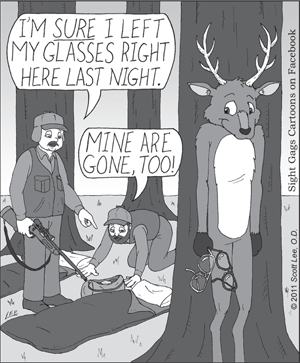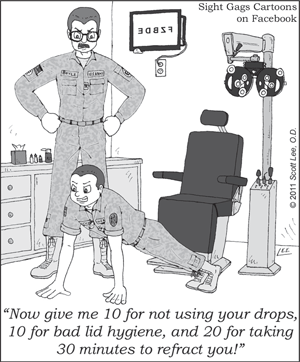Hysterical Vision Loss
First, patients with hysterical vision loss are predominantly female children/adolescents. One of the few male patients I have with this condition was gang raped.
Once all the tests are run to rule out organic causes for the vision loss, the doctor should get permission to call the school nurse or psychologist. It is uncanny how often these kids and their families are a concern to the school. In these cases, the vision specialist’s input results in the school’s initiating a Social Services investigation and the eye care provider may need to testify.
Prior to anticipated testimony in one of these cases, I did a web search on hysterical vision loss and found no information on resolution of the condition once stress is relieved. Clinically, I have seen the MVA return to normal in several of my patients.
Can Third Parties Dictate the Rx?
I found Dr. Deborah Amster’s article “
When Stress Strains Vision” (July 2011) very well done. Working in a pediatric practice, we frequently see these problems.
—William S. Waldman, O.D.
Thornton, Colo.
Recently, our optical department was contacted by VSP, stating that they could not fill a prescription. The optician brought this to my attention and asked that I intervene to get some resolution. I was at first astounded, since it was a valid current prescription for a patient that indeed had coverage.
I thought a little expansion on hysterical vision loss is warranted because it can be due to physical/sexual abuse.
Sight Gags by Scott Lee, O.D.


The patient was a school-aged child. Her Rx was O.D. +0.25 sphere and O.S. +0.75 sphere. During a recent exam, the new prescription was determined to be -0.25 sphere O.U.—a change of -0.50 O.D. and -1.00 O.S. Those of us who are practicing clinicians have seen this many times in this age group where children can change 0.50D or more in a year.
After I called the VSP representative, I was told that the prescription was “too low” to be filled. The representative stated that the Rx was below the threshold of +/-0.50D as a “minimum prescription.”
Although I do not earn any income from the optical, I was astonished that this insurance company could dictate whether this was a “valid” prescription. If this was a commercial practice and the corporate entity dictated what prescriptions were “valid” or not, that would be both illegal and against optometric regulations. Yet an “optometric friendly” third party can and does determine what I can prescribe and it’s not wrong?
The first representative at VSP was unwilling to fulfill the request and I was transferred to a manager. The manager again stated that the Rx was too low and could not be filled according to the guidelines.
I asked her, “What if I had written you a medical prescription for 250mg of amoxicillin and your insurance company stated that only 500mg or more could be filled, how would you feel?” What if her daughter had trouble seeing the board in school—would the insurance company not filling her optical prescription because it was too low cause her any concern?
The VSP manager explained repeatedly that the prescription was too low. I stated that I thought resolution was needed and she stated that VSP would call the patient. I asked her what would they tell the patient—that the prescription was not valid? This implies that either the doctor is a quack or that the insurance is worthless.
After over 20 minutes of my time on the phone, a “one time” exemption was granted and the prescription would be filled as prescribed.
In an era when optometric physicians can practice to the full extent of their license, why is this practice allowed and tolerated? It is either a prescription or not, and the dictation of amount of the prescription should not be a function of any insurance or third party company.
—Robert Simon, O.D.
Franklin, Tenn.
VSP responds:
VSP Vision Care’s long-standing minimum prescription criteria policy, which is reviewed on a regular basis by the doctors on VSP’s board, provides guidelines of when coverage will be provided based upon a threshold of what is visually necessary. That policy is listed below:
The combined power in any meridian is ±0.50 diopters or greater in at least one eye or one of the following exceptions occurs:
• Necessary prism of 0.50 diopters or greater in at least one eye
• Anisometropia is 0.50 diopters or greater
• Cylinder power is ±0.50 diopters or greater
In rare cases, as in this one, we do recognize exceptions to this policy. We respect and value the clinical expertise that Dr. Simon and all independent optometrists provide in order to deliver the best care to VSP members.
To send a Letter to the Editor, e-mail Amy Hellem, editor-in-chief,
ahellem@jobson.com, with “Letter to the Editor” as the subject line.

